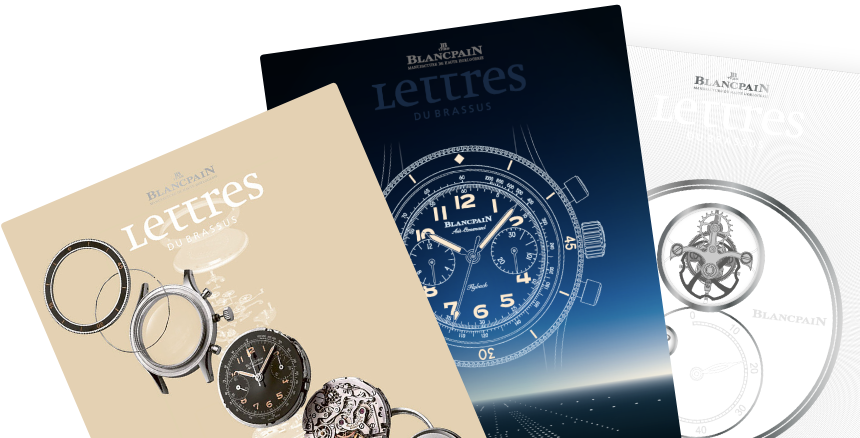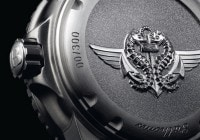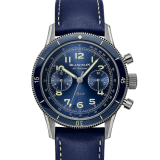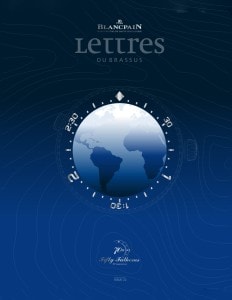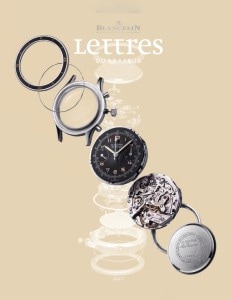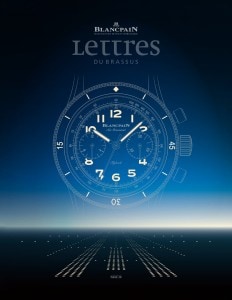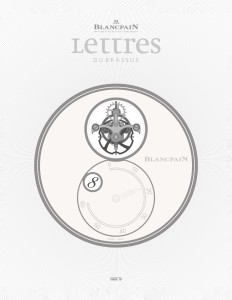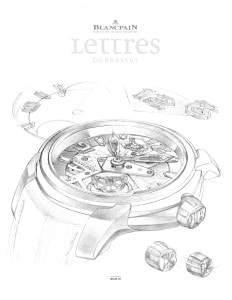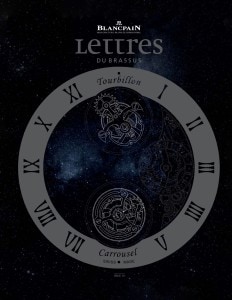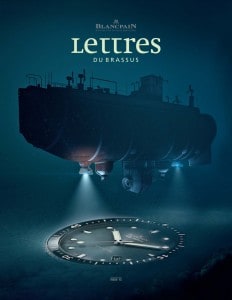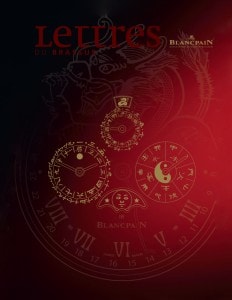
Search in Issues
Chapters
List of parts
Chapter 1
AIR Command
A vintage-inspired chronograph that, like its ancestor, fully responds to the demands of the cockpit.
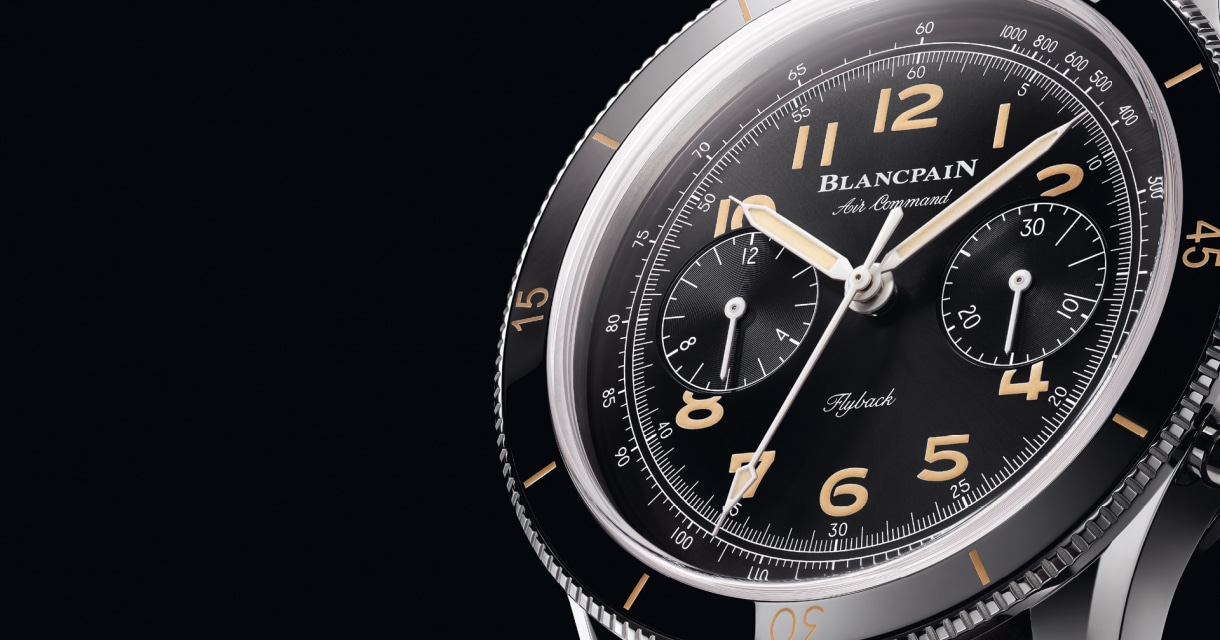
There is a saying: “In life, timing is everything”. Maybe not everything, but in certain domains, its importance cannot be underestimated. Following World War II, before the undersea world could be truly opened up for exploration, divers were in desperate need of a reliable timing instrument to ensure air supply for the duration of the dive. The Blancpain Fifty Fathoms was the first timepiece capable of fulfilling that role. Its pioneering rotating bezel system allowed divers to keep track of their time underwater by aligning the index opposite the minute hand at the start of a dive and reading the elapsed time on the bezel.
In this same era of the 1950s, the aviation world needed timing instruments. Since during a dive the purpose of a timing instrument was to avoid running out of air, in that arena it was sufficient to measure time upon the bezel to within a minute or two. Indeed, when the German Navy ordered its dive watches from Blancpain, they considered that the rotating bezel which would be used for timing needed only one mark, that of the index, and that the diver could estimate the time sufficiently without other markings. The demands of the skies were different. Pilots, particularly when flying under instrument conditions, needed to perform time/distance/ground speed calculations with great precision, measuring intervals to the nearest second. For example, when making an instrument approach to land (the lingo is “shooting an approach”), in many circumstances a pilot descends to a pre-determined minimum altitude which can be maintained for a precisely measured interval after passing a known reference point (termed a “fix”). If the runway does not appear visually after that interval, a missed approach and climb-out must be initiated1. Hopefully, this description triggers thoughts of a chronograph. What better way to measure an interval to within a second than with a chronograph? A pilot would start the chronograph when passing the fix and watch for the pre-determined time to expire. Of course, a chronograph could have been used in the water environment as well, except for one thing. In the 1950s, effective seals for the chronograph pushers had not yet been developed. Thus, for divers, timing was done with the bezel; for pilots with a chronograph.
¹ What is described bears the slightly misleading name: “non-precision“ instrument approach. Although the nomenclature uses the word “non-precision”, great precision in timing is required. Precision approaches, termed “ILS” (Instrument Landing System), are the norm today. ILS approaches, with extraordinary precision, define a ground course aligned with and leading to the runway and a glide slope defining the descent.
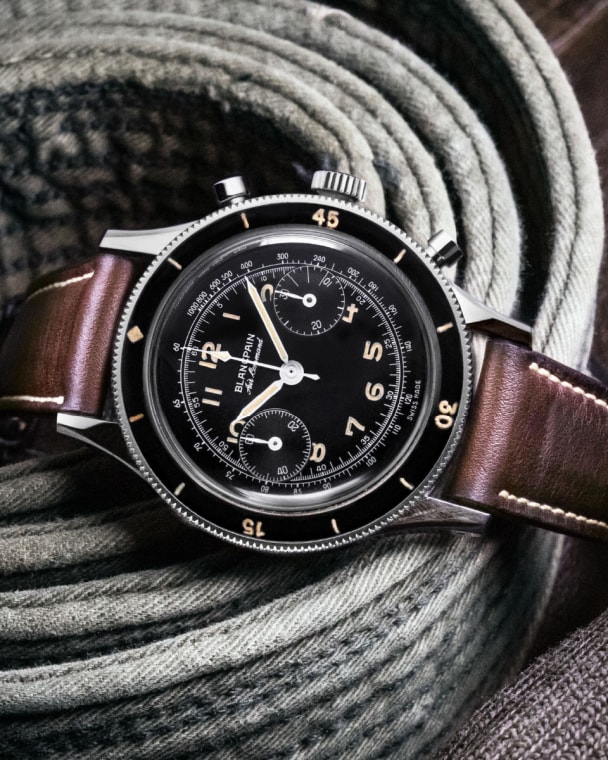
The Blancpain Air Command from the 1950s, now highly sought-after in the auction market.
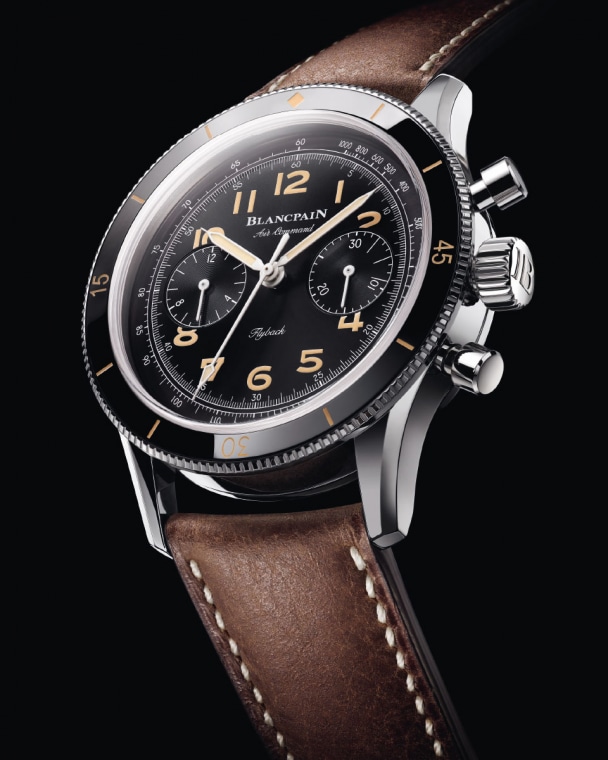
A FULLY-FEATURED aviation instrument must offer TWO SEPARATE TIMING FEATURES: a chronograph, including a flyback function, and a countdown bezel.
The demands of aviation engrafted one additional feature upon the chronograph function. In the course of a flight, the passage of a fix not only calls upon the pilot to note the time interval that has just concluded, but to start another timing event for the course to the next fix2,3. With a classic two-button chronograph, this would require, in order, pushing the top button to stop the running of the chronograph while noting the time, pushing the lower button to re-set to zero, and then pushing the top button a second time to restart the chronograph. Three button pushes. A flyback feature greatly reduces the burden. One push on the lower button stops the running, resets to zero and restarts. Thus, aviation chronographs incorporated this flyback feature.
There is an additional dimension to timing in the air. From the very beginning of their flight training, pilots are taught to think in terms of countdown time. After passing a fix, how many minutes until the next fix is reached? Basically, each fix is a “destination” and monitoring progress to reach that destination is part of flying discipline. A bezel is perfect for enabling this countdown timing. The bezel, however, is marked very differently from that of a dive watch. Divers are measuring elapsed time; thus, the index of the bezel is placed opposite the minute hand at the beginning of the dive and elapsed time is read with the minute hand against the clockwise-arranged markings on the bezel. For aviation countdown timing, the numbers are arranged counterclockwise on the bezel. The pilot places the estimated time to the next fix/destination opposite the minute hand and reads the time remaining on the
bezel. Arrival is estimated to be at the index mark.
Thus, a fully-featured aviation instrument offers two separate timing features. The chronograph for elapsed time, including the flyback function, and a bezel for countdown time. Both have roles to play while in the air.
The Blancpain Air Command watch developed in the 1950s incorporated both: a flyback chronograph with a chronograph seconds hand and 30-minute counter; as well as a countdown-style rotating bezel.
2 Modern navigation systems, whether it be with GPS equipment or VOR (VHF Omnidirectional Range which defines ground radials for a full 360 degree circle around the fixed point of the transmitter) combined with DME (Distance Measuring Equipment) greatly reduce the cockpit burden, giving constant positional information including a running ground speed readout. This was not the case in the 1950s.
3 Indeed timing is so important that pilots are taught that it is the first thing to address when passing a fix. Pilots are drilled to think of ”Five Ts” at a fix: ”Time, Turn, Throttle, Tune, Talk”, amounting to a miniature mental checklist of actions which might be required at a fix. Time is always the first one.
Arguably the AIR COMMAND lays claim to being the RAREst Blancpain of its era.
Arguably the Air Command lays claim to being the most rare of all Blancpains of its era. Unfortunately, that very rarity makes tracing its history challenging. None of the documents relating to its production and sale have been found. The only traces of its past that exist are the less than a handful that have sporadically appeared in the auction market, fetching stratospheric prices, and scattered memories from the descendants of the wider Blancpain family from the 1950s. Piecing together the watches that have been found, the few remembrances, and adding a healthy dose of educated speculation yields a pointillist picture of its past.
Allen V. Tornek was for many decades Blancpain’s U.S. distributor. As recalled by his son, Larry, Tornek sought to repeat his success in winning the competition to secure the Fifty Fathom’s place as the U.S. Navy’s dive watch, this time with the Air Force. Following his standard practice, he persuaded Jean-Jacques Fiechter, who together with his aunt, Betty, led Blancpain, to provide him with a dozen examples of the Air Command to present to the Air Force. Circumstances, however, were different at the Air Force than they had been with the Navy; when Tornek came calling, the Navy had already decided that it needed a diving watch and had formally begun both writing a specification and defining a qualification process. The Air Force had done neither. Thus, Tornek’s presentation of the Air Command watches to the Air Force did not result in a contract; the U.S. Air Force was not then interested in certifying timepieces for its pilots. It seems likely this was because aviation practice at the time had evolved and, rather than utilizing wristwatches, had begun incorporating timing instruments into the panel of the cockpit itself. Indeed, a panel mounted clock had become one of several required instruments for aircraft to fly under Instrument Flight Rules (IFR). Today’s rarity of these vintage pieces suggests that, following the Air Force disappointment, significant serial production of the Air Command did not occur. Exactly how many were assembled remains a mystery.
What is also unclear is whether the development of the Air Command was at the instance of Tornek or internally within Blancpain. There are circumstances that argue for each side of that debate. In favor of a Blancpain-initiated project is the fact that the watch adheres to specifications then published by the French Air Force entitled “Type 20”, which was updated in 1956 to the “Type 21” specification. The combination of a chronograph incorporating the flyback function with a 30-minute counter and a countdown-style rotating bezel are all called out in the French Air Force Type 20/21 specifications. That said, the Type 21 specification from 1956 required that the 30-minute counter feature prominent marks for each five minutes, which the Air Command did not follow. Arguing in favor of the project being driven by Tornek is the name. One of the most noteworthy American films in 1955 was Strategic Air Command starring Jimmy Stewart and June Allyson. It seems too much of a coincidence that the watch would bear the name “Air Command” without the American film being its inspiration.
It also seems that the Air Command is the subject of another debate, one that extends to many pilots’ watches of the era. The minute counter of the chronograph features extended indexes at the 3-6-9-minute markers. Some aviation timepieces of the time, notwithstanding the different approach set out in the French Type 21 specification, went further with prominent indexes at every 3-minute position. Why? There are pundits who argue that this was done to aid pilots in using coin-operated public payphones. Trouble is that 3-minute intervals were not universal. In the U.S., for example, there was no time limit on local pay phone calls. Moreover, even though France did charge calls using that interval, French Air Force pilots had access to a system with no such billing method and
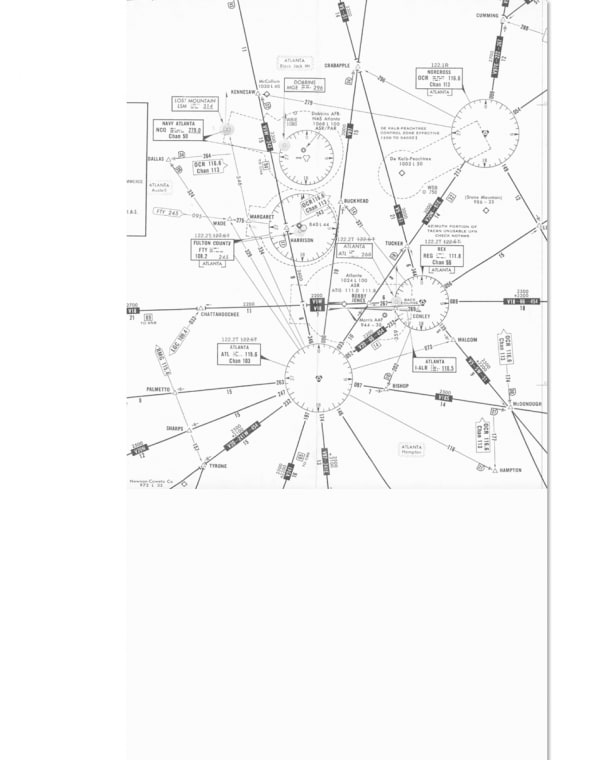
An example of an instrument flying en route chart. The lines show what are termed “Victor Airways” which can be imagined as highways in the sky, each numbered beginning with a “V”. Example V20N defined by the 033 radial of a VOR. The triangles are intersections, example “Bobby Jones” defined by the 033 radial of one VOR and the 267 radial of another. Disciplined pilots track progress carefully along Victor Airway courses.
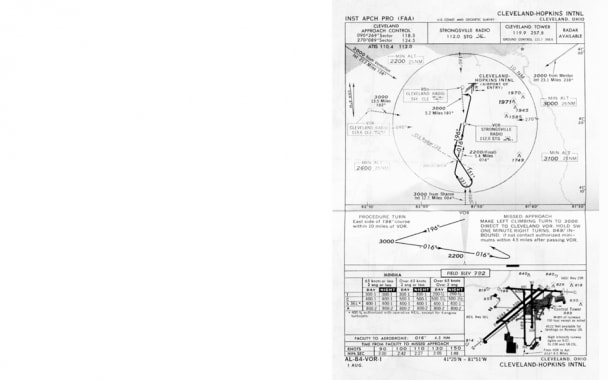
An example of an instrument approach plate. Both the procedure turn to line up on the approach course and the progress after passing the VOR before sighting the runway or initiating a missed approach require precise timing by the pilot.

The NEW AIR COMMAND fully revives the aesthetic of its vintage ancestor and marries it with a MODERN MOVEMENT AND MATERIALS.
the French military specification did not adhere to the 3-minute marking approach. Far more logical is the utility of 3-minute blocks in time/distance calculations. Since speed is universally distance per hour, whether it is aviation’s preferred knots (nautical miles per hour) or miles per hour, minutes need to be converted to fractions of an hour. Three minutes is equal to 1/20th of an hour; and six minutes to 1/10th of an hour. Similarly, 12 minutes corresponds to 1/5th of an hour and 15 minutes to 1/4th. Using these fractions allows a pilot to perform calculations easily in his head. This mental arithmetic was further facilitated by a tachymeter scale on the perimeter of the dial. To determine ground speed, the pilot would measure the time to traverse one nautical mile (or mile) with the chronograph seconds hand and could directly read the speed from the scale. For example, if the time to cover one nautical mile were 30 seconds, the ground speed would be 120 knots, as shown on the tachymeter.
Blancpain’s new Air Command fully revives the spirit of the vintage pilot’s timepiece. Faithful to its heritage, it offers both a chronograph including a flyback function, with prominent markers at 3-minute points, and a countdown style rotating bezel. Aesthetically, it faithfully captures the look and style of its predecessors: case, hands, dial (including the tachymeter), bezel, form of the pump-style chronograph pushers and crown all echo the 1950s version. The vintage theme is evoked as well by the brown leather strap with white stitching affixed to the watch.
The chronograph runs at a 5 Hz frequency, EACH SECOND DIVIDED INTO TENTHS.
In all other respects, Blancpain’s new Air Command is thoroughly modern. Its in-house caliber F388B movement (a variation of the F385) features a free sprung balance with a silicon hairspring running at 5 Hz. This design reflects Blancpain’s movement philosophy of today oriented toward both precision and robustness. The free sprung balance with inertial regulation screws is conceived to facilitate fine rate adjustments and shock resistance. The silicon hairspring, in comparison with pre-existing metallic hairsprings, is resistant to magnetism as well as offering greater timing precision over the full power reserve. The 5 Hz frequency not only enhances its precision but neatly divides each second into 1/10th intervals, ideal for a chronograph. It is also based upon Blancpain’s highly evolved vertical clutch design which ensures perfect starting and stopping without the occasional jumps which occur with horizontal clutch architectures. Unlike its predecessor, the modern Air Command offers automatic winding, made doubly attractive as the red gold winding rotor is in the shape of an airplane propeller.
Modern materials enhance the 42.5 mm stainless steel case. The countdown bezel on the vintage piece had a Bakelite insert. Today it is made of scratch-resistant ceramic. Of course, the plexiglass crystal of the 1950s is now in sapphire fashioned into the shape of what is termed a “glass box”, whose slightly raised edge brings additional light to the dial. The solid caseback of the past has been replaced by clear sapphire, also in the form of a glass box, affording an enhanced view of the movement.
The new Air Command is a limited edition with but 500 examples.

Other issues
Don't miss the latest issue
Sign Up for New Releases